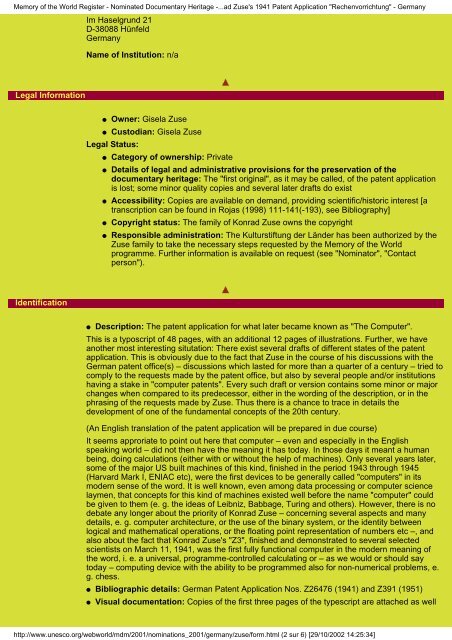Konrad Zuse's 1941 Patent Application - Unesco
Konrad Zuse's 1941 Patent Application - Unesco
Konrad Zuse's 1941 Patent Application - Unesco
You also want an ePaper? Increase the reach of your titles
YUMPU automatically turns print PDFs into web optimized ePapers that Google loves.
Memory of the World Register - Nominated Documentary Heritage -...ad <strong>Zuse's</strong> <strong>1941</strong> <strong>Patent</strong> <strong>Application</strong> "Rechenvorrichtung" - Germany<br />
Legal Information<br />
Identification<br />
Im Haselgrund 21<br />
D-38088 Hünfeld<br />
Germany<br />
Name of Institution: n/a<br />
● Owner: Gisela Zuse<br />
● Custodian: Gisela Zuse<br />
Legal Status:<br />
● Category of ownership: Private<br />
● Details of legal and administrative provisions for the preservation of the<br />
documentary heritage: The "first original", as it may be called, of the patent application<br />
is lost; some minor quality copies and several later drafts do exist<br />
● Accessibility: Copies are available on demand, providing scientific/historic interest [a<br />
transcription can be found in Rojas (1998) 111-141(-193), see Bibliography]<br />
● Copyright status: The family of <strong>Konrad</strong> Zuse owns the copyright<br />
● Responsible administration: The Kulturstiftung der Länder has been authorized by the<br />
Zuse family to take the necessary steps requested by the Memory of the World<br />
programme. Further information is available on request (see "Nominator", "Contact<br />
person").<br />
● Description: The patent application for what later became known as "The Computer".<br />
This is a typoscript of 48 pages, with an additional 12 pages of illustrations. Further, we have<br />
another most interesting situtation: There exist several drafts of different states of the patent<br />
application. This is obviously due to the fact that Zuse in the course of his discussions with the<br />
German patent office(s) – discussions which lasted for more than a quarter of a century – tried to<br />
comply to the requests made by the patent office, but also by several people and/or institutions<br />
having a stake in "computer patents". Every such draft or version contains some minor or major<br />
changes when compared to its predecessor, either in the wording of the description, or in the<br />
phrasing of the requests made by Zuse. Thus there is a chance to trace in details the<br />
development of one of the fundamental concepts of the 20th century.<br />
(An English translation of the patent application will be prepared in due course)<br />
It seems approriate to point out here that computer – even and especially in the English<br />
speaking world – did not then have the meaning it has today. In those days it meant a human<br />
being, doing calculations (either with or without the help of machines). Only several years later,<br />
some of the major US built machines of this kind, finished in the period 1943 through 1945<br />
(Harvard Mark I, ENIAC etc), were the first devices to be generally called "computers" in its<br />
modern sense of the word. It is well known, even among data processing or computer science<br />
laymen, that concepts for this kind of machines existed well before the name "computer" could<br />
be given to them (e. g. the ideas of Leibniz, Babbage, Turing and others). However, there is no<br />
debate any longer about the priority of <strong>Konrad</strong> Zuse – concerning several aspects and many<br />
details, e. g. computer architecture, or the use of the binary system, or the identity between<br />
logical and mathematical operations, or the floating point representation of numbers etc –, and<br />
also about the fact that <strong>Konrad</strong> <strong>Zuse's</strong> "Z3", finished and demonstrated to several selected<br />
scientists on March 11, <strong>1941</strong>, was the first fully functional computer in the modern meaning of<br />
the word, i. e. a universal, programme-controlled calculating or – as we would or should say<br />
today – computing device with the ability to be programmed also for non-numerical problems, e.<br />
g. chess.<br />
● Bibliographic details: German <strong>Patent</strong> <strong>Application</strong> Nos. Z26476 (<strong>1941</strong>) and Z391 (1951)<br />
● Visual documentation: Copies of the first three pages of the typescript are attached as well<br />
http://www.unesco.org/webworld/mdm/2001/nominations_2001/germany/zuse/form.html (2 sur 6) [29/10/2002 14:25:34]
















